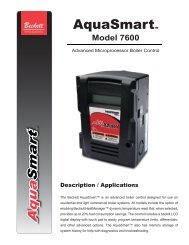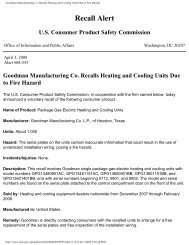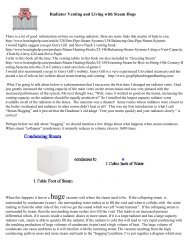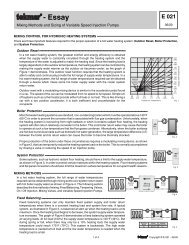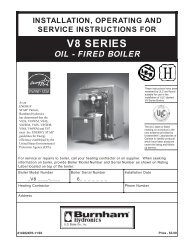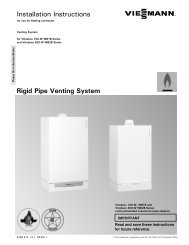Steam Locomotive Firebox Explosion on the Gettysburg Railroad ...
Steam Locomotive Firebox Explosion on the Gettysburg Railroad ...
Steam Locomotive Firebox Explosion on the Gettysburg Railroad ...
You also want an ePaper? Increase the reach of your titles
YUMPU automatically turns print PDFs into web optimized ePapers that Google loves.
According to <strong>the</strong> regulati<strong>on</strong>s, <strong>the</strong> boiler<br />
must be washed <strong>on</strong>ce a m<strong>on</strong>th and <strong>the</strong><br />
spindles must be reamed. When asked if <strong>the</strong><br />
amount of scale found in <strong>the</strong> spindles could<br />
have accumulated between m<strong>on</strong>thly<br />
cleanings, <strong>on</strong>e steam-locomotive expert said,<br />
“No, no possible way.” Ano<strong>the</strong>r said, “I<br />
have never seen a locomotive that had as<br />
much scale inside <strong>the</strong> water-glass spindle as<br />
<strong>the</strong> 1278. I worked <strong>on</strong> a lot of locomotives<br />
all over <strong>the</strong> country and never saw anything<br />
like this.” The chief mechanical officer<br />
(CMO) of <strong>the</strong> Strasburg <strong>Railroad</strong> speculated<br />
that in such a restricted c<strong>on</strong>diti<strong>on</strong>, <strong>the</strong><br />
spindles would be much more susceptible to<br />
being blocked by floating material or scale<br />
flake. The investigators were unanimous in<br />
<strong>the</strong>ir c<strong>on</strong>victi<strong>on</strong> that <strong>the</strong> amount of scale<br />
found in <strong>the</strong> spindles could not possibly<br />
have accumulated within <strong>the</strong> relatively short<br />
time between m<strong>on</strong>thly boiler washings,<br />
Figure 12. End view of plugged spindle.<br />
regardless of <strong>the</strong> c<strong>on</strong>diti<strong>on</strong> of <strong>the</strong> water used.<br />
(See figure 13.)<br />
The water glass itself was a glass tube<br />
about 12 inches l<strong>on</strong>g and 1/2 inch in diameter.<br />
Running <strong>the</strong> length of <strong>the</strong> glass was<br />
a 1/4-inch-wide faded red background line<br />
that was barely visible. The diameter of <strong>the</strong><br />
bore (about 1/8 inch) appeared smaller than<br />
<strong>the</strong> 3/8-inch bore with which <strong>the</strong> inspectors<br />
were more familiar. They c<strong>on</strong>sidered<br />
whe<strong>the</strong>r a smaller bore would be more<br />
susceptible to some form of capillary acti<strong>on</strong><br />
or to being plugged by lose scale (ei<strong>the</strong>r of<br />
which could yield a false reading). However,<br />
after <strong>the</strong>y examined and tested <strong>the</strong> glass,<br />
<strong>the</strong>y decided <strong>the</strong> diameter of <strong>the</strong> bore was<br />
acceptable. (See figure 14.)<br />
Safety Board investigators used a flexible<br />
clear plastic hose to measure <strong>the</strong> resp<strong>on</strong>se of<br />
23



